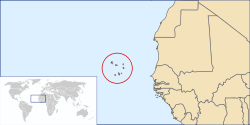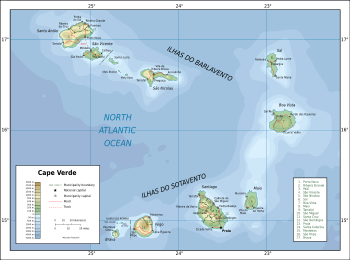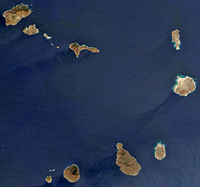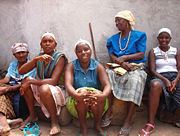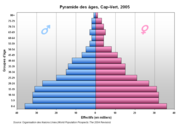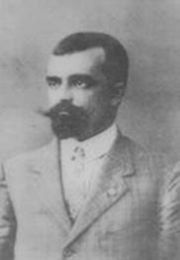Cape Verde
2008/9 Schools Wikipedia Selection. Related subjects: Africa; African Countries
| República de Cabo Verde Republic of Cape Verde
|
||||||
|---|---|---|---|---|---|---|
|
||||||
| Anthem: Cântico da Liberdade |
||||||
|
|
||||||
| Capital (and largest city) |
Praia |
|||||
| Official languages | Portuguese | |||||
| Recognised regional languages | Cape Verdean Creole | |||||
| Demonym | Cape Verdean | |||||
| Government | Republic | |||||
| - | President | Pedro Pires | ||||
| - | Prime Minister | José Maria Neves | ||||
| Independence | from Portugal | |||||
| - | Recognised | July 5, 1975 | ||||
| Area | ||||||
| - | Total | 4,033 km² ( 172nd) 1,557 sq mi |
||||
| - | Water (%) | negligible | ||||
| Population | ||||||
| - | 2008 estimate | 499,796 ( 165th) | ||||
| - | 2000 census | 436,821 | ||||
| - | Density | 126/km² ( 79th) 326/sq mi |
||||
| GDP ( PPP) | 2006 estimate | |||||
| - | Total | $3.905 billion ( 157th) | ||||
| - | Per capita | $7,904 ( 90th) | ||||
| HDI (2007) | ▲ 0.736 (medium) ( 102nd) | |||||
| Currency | Cape Verdean escudo ( CVE) |
|||||
| Time zone | CVT ( UTC-1) | |||||
| - | Summer ( DST) | not observed ( UTC-1) | ||||
| Internet TLD | .cv | |||||
| Calling code | +238 | |||||
The Republic of Cape Verde (Portuguese: Cabo Verde, IPA: ['kabu 'veɾdɨ]), is a republic located on an archipelago in the Macaronesia ecoregion of the North Atlantic Ocean, off the western coast of Africa. The previously uninhabited islands were discovered and colonized by the Portuguese in the fifteenth century (though there may have been earlier discoveries), and attained independence in 1975.
Naming
Cape Verde is named after Cap Vert (meaning Green Cape) in Senegal, the westernmost point of continental Africa. The country's name can be pronounced many ways in English. Cape is pronounced like the article of clothing, and Verde is pronounced either to rhyme with "bird", "birdy", "bear D", or "bear day". "Cabo" is not used in English.
History
Cape Verde was uninhabited when the Portuguese arrived in 1460 and made the islands part of the Portuguese empire. Due to its location off the coast of Africa, Cape Verde became an important watering station, then sugar cane plantation site, and later a major hub of the trans-atlantic slave trade, that would later form the contemporary African Diaspora.
In 1975, Cape Verde achieved independence from Portugal after a long armed struggle in the jungles of Guinea-Bissau. The African Party for the Independence of Guinea-Bissau and Cape Verde ( PAIGC) was the main entity responsible for the independence of Cape Verde. Moreover, the people's revolutionary armed forces of Cuba, too, played a role in the Cape Verdean independence armed struggle in Guinea-Bissau. After independence, the PAIGC attempted to unite Cape Verde and Guinea-Bissau into one nation, the PAIGC controlling both governments, but a coup in the latter nation in 1980 ended these plans. As a result, the G, standing for Guinea-Bissau, in PAIGC was dropped. Consequently, PAICV (African Party for the Independence of Cape Verde) was formed. In Cape Verde the PAICV (affiliated with the PAIGC) governed until democratic elections, held in 1991, resulted in a change of government. The Movimento para a Democracia (MPD) won that election. The MPD was re-elected in 1996. The PAICV returned to power in 2001, and was re-elected in 2006.
Politics
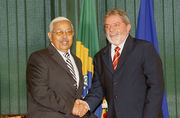
Politics of Cape Verde takes place in a framework of a parliamentary representative democratic republic, whereby the Prime Minister of Cape Verde is the head of government, and of a multi-party system. Executive power is held by the government. Legislative power is vested in both the government and the National Assembly. The Judiciary is independent of the executive and the legislature.
Municipalities and parishes
Cape Verde is divided into 22 municipalities (concelhos), and subdivided into 32 parishes (freguesias).
Geography
Cape Verde is an archipelago off the west coast of Africa at 15.02N, 23.34W. It is formed by 10 main islands and about 8 islets. The main islands are:
- Barlavento (northern island group)
- Santo Antão
- São Vicente
- Santa Luzia
- São Nicolau
- Sal
- Boa Vista
- Sotavento (southern island group)
- Maio
- Santiago
- Fogo
- Brava
Of these, only Santa Luzia and the five islets are uninhabited. Presently it is a natural reserve. All islands are volcanic, but an active volcano only exists on one of the islands, Fogo (see Mount Fogo).
Environment
The isolation of Cape Verde about 500 km (310 mi) from the African mainland has resulted in the islands having a large number of endemic species, many of which are endangered by human development. Endemic birds include Alexander's Swift (Apus alexandri), Raso Lark (Alauda razae), Cape Verde Warbler (Acrocephalus brevipennis), and Iago Sparrow (Passer iagoensis), and reptiles include the Cape Verde Giant Gecko (Tarentola gigas).
Charles Darwin gives a vivid description of the geology, climate, zoology and botany of the islands in the first chapter of his book The Voyage of the Beagle.
Climate
Cape Verde is in the tropical zone. Average temperatures range from 24 °C (75 °F) in January and February to 29 °C (85 °F) in September. The average annual rainfall for Cape Verde is 68.4 mm (2.7 in), with September being the wettest month with 33.6 mm (1.3 in). Conversely, the months April to July record less than one millimetre of rainfall each. The climate is arid, but Cape Verde's position in the Atlantic contributes to soften the aridity, that otherwise would be the same aridity as that in continental areas.
Economy
Cape Verde is a small nation that lacks resources and has experienced severe droughts. Agriculture is made difficult by lack of rain and is restricted to only four islands for most of the year. Most of the nation's GDP comes from the service industry. Cape Verde's economy has grown since the late 1990s, and it is now considered a country of average development. Cape Verde has significant cooperation with Portugal at every level of the economy, which has led it to link its currency first to the Portuguese escudo and, in 1999, to the euro.
Former Portuguese prime minister José Manuel Durão Barroso, now (second semester 2004) president of the European Commission, has promised to help integrate Cape Verde within the European Union sphere of influence via greater cooperation with Portugal. In March 2005, former Portuguese president Mário Soares launched a petition urging the European Union to start membership talks with Cape Verde.
In 2007 the United Nations graduated Cape Verde from the category of Least Developed Countries, only the second time this has happened to a country.
Cape Verde has been on the list of the United Nations Small Island Developing States, and is considered a Developing country in economic terms.
On 18 December 2007, the General Council of the World Trade Organization approved a package for the accession of Cape Verde to the WTO. Accession will be effective 30 days after it is ratified by Cape Verde, which must take place by 30 June 2008. The package requires Cape Verde to adapt some of its economic regulation. In particular, it will need to introduce a new Customs Code, and to introduce copyright and patent laws complying with the Agreement on Trade-Related Aspects of Intellectual Property Rights.
Demographics
Most inhabitants of Cape Verde are a genetic blend of Sub-Saharan Africans and Europeans, the Africans having been slaves and hailing mostly from Senegal, Gambia and Guinea-Bissau. Cape Verdeans' European ancestors include Portuguese settlers and exiles, Portuguese Jews who were victims of the Inquisition, and Spanish and Italian seamen who were granted land by the Portuguese Empire. Many foreigners from other parts of the world settled Cape Verde as their permanent country. Most of them were Dutch, French, British, Arabs and Jews (from Lebanon and Morocco), Chinese (especially from Macau), Americans, and Brazilians (including people of Portuguese and African descent) settlers. All of these have been absorbed into the general Cape Verdean population.
The majority of the population adheres to Christianity, mostly Catholicism which constitutes some 90% of the population (in many areas Catholicism and traditional African religions are syncretised). The remaining includes a sizeable Protestant community as well as a small number of Bahá'í and Buddhist and even smaller Muslim groups.
Cape Verde has been steadily developing since its independence, and besides having been promoted to the group of "medium development" countries in 2007, leaving the Least Developed Countries category (which is only the second time it has happened to a country), is currently the 5th best ranked country in Africa in terms of Human Development Index.
Cape Verdean diaspora
The Cape Verdean diaspora refers to both historical and present emigration from Cape Verde. Today, more Cape Verdeans live abroad than in Cape Verde itself, with significant emigrant Cape Verdean communities in the United States (500,000 Cape Verdeans, with a major concentration on the New England coast from Providence, R.I., to New Bedford, Mass.), Portugal (80,000) and Angola (45,000). There is also a significant number of Cape Verdeans in São Tomé and Príncipe, Senegal, France, Brazil, Luxembourg and the Netherlands. Cape Verdean populations also settled in Spain, Germany, and other CPLP countries such as Guinea-Bissau.
Culture
The culture of Cape Verde reflects its mixed African and Portuguese roots. It is well known for its diverse forms of music such as Morna and a wide variety of dances: the soft dance Morna, and its modernized version, passada, the Funaná - a sensual mixed Portuguese and African dance, the extreme sensuality of coladeira, and the Batuque dance. These are reflective of the diverse origins of Cape Verde's residents. The term "Criolo" is used to refer to residents as well as the culture of Cape Verde.
Cape Verdean literature
Cape Verdean literature is one of the richest of Lusitanian Africa.
- Poets: Frusoni Sergio (linked site is in Portuguese), Tavares Eugénio (linked site is in Portuguese), B.Léza, João Cleofas Martins, Luís Romano de Madeira Melo, Ovídio Martins, Barbosa Jorge, Fortes Corsino António, Baltasar Lopes (Osvaldo Alcântara), João Vário, Oswaldo Osório, Arménio Vieira, Vadinho Velhinho, José Luís Tavares, Carlos Baptista, etc.
- Authors: Manuel Lopes, Henrique Teixeira de Sousa, Almeida Germano, Luís Romano de Madeira Melo, Germano de Almeida, Orlanda Amarilis, Jorge Vera Cruz Barbosa, Pedro Cardoso, Mário José Domingues, Daniel Filipe, Mário Alberto Fonseca de Almeida, Corsino António Fortes, Arnaldo Carlos de Vasconcelos França, António Aurélio Gonçalves, Aguinaldo Brito Fonseca, Ovídio de Sousa Martins, Osvaldo Osório, Dulce Almada Duarte, Manuel Veiga
- Poems in Portuguese: Cape Verdean Poems, Poesia
- Cape Verdean Literature
- Sopinha de Alfabeto
- Famous tales: Ti Lobo and Chibinho
Music
Cape Verde is known internationally for morna, a form of folk music usually sung in the Cape Verdean Creole, accompanied by clarinet, violin, guitar and cavaquinho. The islands also boast funaná and batuque music.
Cesária Évora is perhaps the best internationally-known practitioner of morna. Madonna is so inspired by her that she even purchased a house on the island of Sal.
Language
Cape Verde's official language is Portuguese. It is the language of instruction and official acts. However, the Cape Verdean Creole is used colloquially and is the mother tongue of virtually all Cape Verdeans. Cape Verdean Creole or Kriolu is a dialect continuum of a Portuguese-based creole, which varies from island to island.
There is a substantial body of literature in Creole, especially in the Santiago Creole and the São Vicente Creole. Creole has been gaining prestige since the nation's independence from Portugal.
However, the differences between the varied forms of the language within the islands have been a major obstacle in the way of standardization of the language. Some people have advocated the development of two standards: a North (Barlavento) standard, centered on the São Vicente Creole, and a South (Sotavento) standard, centered on the Santiago Creole. Manuel Veiga, PhD, a linguist by training, and Minister of Culture of Cape Verde, is the premier proponent of Kriolu's officialization and standardization.
Transportation
TACV Cabo Verde Airlines is a scheduled and charter, passenger and cargo airline based in Cape Verde. It is the national flag carrier of Cape Verde, operating an inter-island service and flights to Europe, North America, South America and the West African mainland. Its main base is Sal Airport (SID), with a hub at Praia Airport (RAI).
Newspapers
- A Semana (Praia, since 1991)
- Expresso das Ilhas
- Jornal O Cidadão (São Vicente)
- Jornal Horizonte (Praia, since 1988)
- Terra Nova (S.Vicente, since 1975)
- Artiletra (S.Vicente, since 1991)
Online
- CaboSpace (Cape Verdean American)
- CaboVerdeOnline
- Cape Verde Portal
- Inforpress news agency
- Visão News
- O Liberal
- CVN (Cape Verdean American)
- FORCV (Cape Verdean American)


